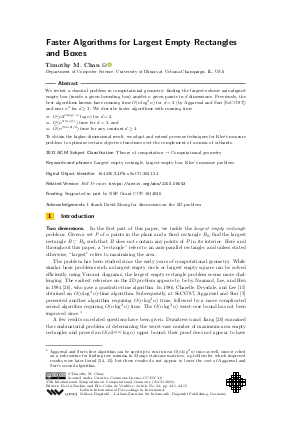@InProceedings{chan:LIPIcs.SoCG.2021.24,
author = {Chan, Timothy M.},
title = {{Faster Algorithms for Largest Empty Rectangles and Boxes}},
booktitle = {37th International Symposium on Computational Geometry (SoCG 2021)},
pages = {24:1--24:15},
series = {Leibniz International Proceedings in Informatics (LIPIcs)},
ISBN = {978-3-95977-184-9},
ISSN = {1868-8969},
year = {2021},
volume = {189},
editor = {Buchin, Kevin and Colin de Verdi\`{e}re, \'{E}ric},
publisher = {Schloss Dagstuhl -- Leibniz-Zentrum f{\"u}r Informatik},
address = {Dagstuhl, Germany},
URL = {https://drops.dagstuhl.de/entities/document/10.4230/LIPIcs.SoCG.2021.24},
URN = {urn:nbn:de:0030-drops-138231},
doi = {10.4230/LIPIcs.SoCG.2021.24},
annote = {Keywords: Largest empty rectangle, largest empty box, Klee’s measure problem}
}

 Creative Commons Attribution 4.0 International license
Creative Commons Attribution 4.0 International license

